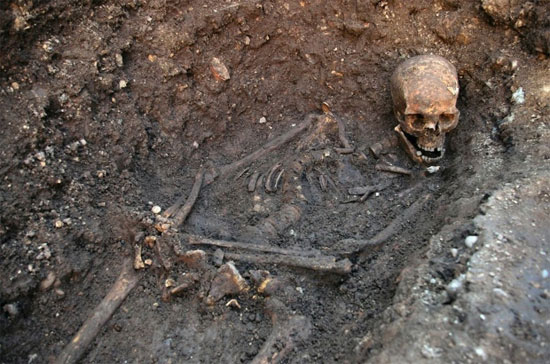Diagnosis for King Richard III
Not only is one of the most despised kings in British history, Richard III also faces contempt because the ugly, humped appearance is infected with parasites that make his feet unusually large.
>>>Haven't decided where to bury King Richard III
The University of Leicester researchers have just announced a new discovery about the remains of the ill-fated king, who was burnt, unscathed at the place where the parking lot is now located in England. They said they had found countless nematode eggs in the soil around the pelvis of the object, which once contained his intestine. Experts compared the soil sample with soil samples near the skull and around the tomb of King Richard. The results show that the soil around the skull has no worms, and only traces of worm eggs near the grave.
In the report published in the Lancet journal, the researchers believe that in children, nematodes can curb growth and reduce intelligence, but for kings living in silk velvet, excess food Wear, parasites can be just a little trouble.'Richard almost certainly does not lack food to share with the worms' community , according to Fox News, quoted Piers Mitchell, a professor of anthropology at Cambridge University, one of the researchers. Mr. Mitchell said this was also the first time a British king had been found to be infected with worms.

King Richard III's remains in a state of rapid burial - (Photo: Leicester University)
However, the king still suffered from a number of symptoms of worm infection, usually after a person eats the eggs in contaminated food. Once the eggs hatch, the larvae enter the lungs and throat, where they are digested back into the small intestine.'When worms move in the body, they can cause coughing and discomfort, like they are swallowing worms,' says Professor Mitchell. He guessed that the physicians could not know these symptoms were related to the emperor's worm infection, and must have done the usual treatments, including blood extraction. However, Professor Anh suspects that the ability of helminths may be worse than Richard III's scoliosis. William Shakespeare's drama depicts him as a hunchbacked, ruthless regent killing two young nephews to win the British throne.
Worm infestation could also push King Richard III into disgust when he died on the battlefield in 1485. He was also the last King of England to die in the field. In adults with nematode worms, catastrophic events such as car crashes can cause worms to spread from the nose and ears.'They are shocked to find the fastest exit route , ' says Simon Brooker, a pathologist at the School of Tropical and Hygiene in London. Brooker said it was possible that Richard caught too many sword wounds before he died, causing the worms to escape from the body.
About 820 million people worldwide are infected with nematode worms, and can easily be treated with cheap and disposable drugs. Helminths threaten people throughout the history of human development. Roundworms, tapeworms, hookworms, whip profits have haunted us for thousands of years. Among the oldest evidence, 10,000-year-old solid waste found in Utah has contained traces of pinworms. Ascaris lumbricoides, the nematode whose eggs were found in the tomb of King Richard III, infested from settlers in Peru in 2277 BC, and in Brazil around 1600 BC. They were also discovered in an Egyptian claim dating to about 1600 BC. In June of this year, the researchers published a report showing that King Richard's crusade corpses were stopped on the way to battle, only to lose to the parasite 'enemy'. .
- King Richard III will be buried
- Revealed inside the tomb of King Richard III
- Delete oan for King Richard III
- Question: The location of King Richard III's tomb in England is in the car park
- It has not been decided where to bury King Richard III
- Find out the cause of King Richard III's death
- Preserve the King of England with 3D technology
- Find the British king's remains under the parking lot
- The luxurious diet of the ancient king of England
- Very interesting truth about British emperors
- One of the most mysterious cases in British history will be decoded, if ...
- Who is BB King and what is Google celebrating today?
 Green tea cleans teeth better than mouthwash?
Green tea cleans teeth better than mouthwash? Death kiss: This is why you should not let anyone kiss your baby's lips
Death kiss: This is why you should not let anyone kiss your baby's lips What is salmonellosis?
What is salmonellosis? Caution should be exercised when using aloe vera through eating and drinking
Caution should be exercised when using aloe vera through eating and drinking